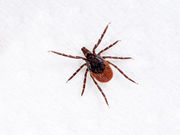Residents in nearly half of all counties now at risk, CDC says
TUESDAY, Jan. 19, 2016 (HealthDay News) — Ticks that transmit Lyme disease are now found in nearly half of all counties in the United States, a much broader swath than was seen in the late 1990s, according to research published online Jan. 18 in the Journal of Medical Entomology.
Researchers analyzed available data and found black-legged ticks reported in 45.7 percent of U.S. counties, compared with 30 percent of counties in 1998. They also found that the black-legged tick is now considered established in twice as many counties as in 1998.
Most of the ticks’ expansion in range has occurred in the northern United States. Its distribution in southern states has remained fairly stable, with the range of the western black-legged tick only increasing to 3.6 percent of counties from 3.4 percent in 1998, the researchers found.
The findings show “that the distribution of Lyme disease vectors has changed substantially over the last nearly two decades and highlights areas where risk for human exposure to ticks has changed during that time,” study author Rebecca Eisen, M.D., a research biologist at the U.S. Centers for Disease Control and Prevention in Atlanta, said in a journal news release. “The observed range expansion of the ticks highlights a need for continuing and enhancing vector surveillance efforts, particularly along the leading edges of range expansion.”
Full Text
Copyright © 2016 HealthDay. All rights reserved.








